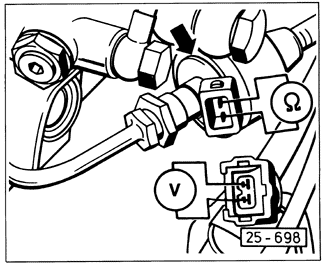Checking Frequency ValveTo check the frequency valve, jumper the fuel pump relay to operate the fuel pump without running the engine, as described in FUEL SYSTEM-GASOLINE. On Golf models, it is also necessary to turn on the ignition to operate the pump. With the pump running, the frequency valve should make a repeating clicking or buzzing sound, indicating that the valve is operating correctly. If so, disconnect the fuel pump jumper and reinstall the relay. To continue testing the oxygen sensor system, go to the next test, Checking Oxygen Sensor System Control Unit. If no clicking sound is heard, remove the frequency valve harness connector and, using an ohmmeter, measure the resistance of the valve's windings as shown in Fig. 5-3. If the resistance is not 2 to 3 ohms, replace the frequency valve as described below. Check that the valve is getting power by testing for voltage at the harness connector (Fig. 5-3). Once again, operate the fuel pump by jumpering the relay terminals. There should be voltage at one of the two connector terminals. If not, the system wiring or the power supply relay or the control unit is faulty. See Troubleshooting Oxygen Sensor Circuits.

To replace the frequency valve, clean and disconnect the fuel line unions. Loosen the mounting clamp bolt and press the valve out of the rubber bushing in the clamp. Installation is the reverse of removal. Use new sealing washers when reconnecting the fuel lines.
|